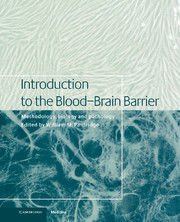Book contents
- Frontmatter
- Contents
- List of contributors
- 1 Blood–brain barrier methodology and biology
- Part I Methodology
- Part II Transport biology
- Part III General aspects of CNS transport
- Part IV Signal transduction/biochemical aspects
- 31 Regulation of brain endothelial cell tight junction permeability
- 32 Chemotherapy and chemosensitization
- 33 Lipid composition of brain microvessels
- 34 Brain microvessel antigens
- 35 Molecular dissection of tight junctions: occludin and ZO-1
- 36 Phosphatidylinositol pathways
- 37 Nitric oxide and endothelin at the blood–brain barrier
- 38 Role of intracellular calcium in regulation of brain endothelial permeability
- 39 Cytokines and the blood-brain barrier
- 40 Blood–brain barrier and monoamines, revisited
- Part V Pathophysiology in disease states
- Index
35 - Molecular dissection of tight junctions: occludin and ZO-1
from Part IV - Signal transduction/biochemical aspects
Published online by Cambridge University Press: 10 December 2009
- Frontmatter
- Contents
- List of contributors
- 1 Blood–brain barrier methodology and biology
- Part I Methodology
- Part II Transport biology
- Part III General aspects of CNS transport
- Part IV Signal transduction/biochemical aspects
- 31 Regulation of brain endothelial cell tight junction permeability
- 32 Chemotherapy and chemosensitization
- 33 Lipid composition of brain microvessels
- 34 Brain microvessel antigens
- 35 Molecular dissection of tight junctions: occludin and ZO-1
- 36 Phosphatidylinositol pathways
- 37 Nitric oxide and endothelin at the blood–brain barrier
- 38 Role of intracellular calcium in regulation of brain endothelial permeability
- 39 Cytokines and the blood-brain barrier
- 40 Blood–brain barrier and monoamines, revisited
- Part V Pathophysiology in disease states
- Index
Summary
Barrier function of tight junctions
The establishment of compositionally distinct fluid compartments by various types of cell sheets is crucial for the development and function of most organs in multicellular organisms. Since these cell sheets consist of two-dimensionally arranged cells, some mechanism is required to seal cells to create a primary barrier to the diffusion of solutes through the paracellular pathway. This mechanism is thus essential for morphogenesis of the multicellular system, and the tight junction, an element of epithelial and endothelial junctional complexes, is now believed to be directly involved in this mechanism (Schneeberger and Lynch, 1992; Gumbiner, 1987, 1993). The brain is an important compartment that is protected by a barrier of endothelial cell sheets bearing well-developed tight junctions. This is referred as the blood-brain barrier.
In thin-section electron microscopy, tight junctions appear as a series of discrete sites of apparent fusion, involving the outer leaflet of the plasma membrane of adjacent cells (Farquhar and Palade, 1963). In freeze-fracture electron microscopy, this junction appears as a set of continuous, anastomosing intramembrane strands or fibrils in the Pface (the outwardly facing cytoplasmic leaflet) with complementary grooves in the E-face (the inwardly facing extracytoplasmic leaflets) (Staehelin, 1974). It has remained controversial whether the strands are predominantly lipid in nature, that is, cylindrical lipid micelles, or represent linearly aggregated integral membrane proteins (Kachar and Reese, 1982; Pinto da Silva and Kachar, 1982).
- Type
- Chapter
- Information
- Introduction to the Blood-Brain BarrierMethodology, Biology and Pathology, pp. 322 - 329Publisher: Cambridge University PressPrint publication year: 1998
- 5
- Cited by



